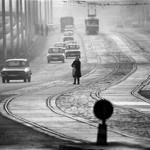While chatting recently with a client, he asked me how I saw myself as a professional, if I thought I was an engineer or an artist. I must admit I have not wondered about the genus proximus for a long time. An architect is an architect. He does things that are different from the one and the other at the same time.
We could equally say that his vocation is to create a synthesis; he is destined to have a comprehensive vision and coordinate things; he could be seen as a stage director of spatial states, a conductor of matter, an engineer of the world of senses, etc. We could go at length with periphrases describing this ambivalence between reason and inspiration in our profession.
As it happened… shortly after this question I visited two exhibitions and received an issue from A10 magazine that made me find some subtler channels of communication with this topic. This time, I might choose to tip the scale in favour of the artistic line, because they made me feel very comfortable.
Horia Damian – Romanian artist in Paris. He has studied architecture, so he’s an architect. He paints spaces, constructs installations with architectural elements, walls, columns, windows. He has indeed intuition and philosophical understanding of space. I liked one installation in particular: an exposed brick wall, with numbered bricks. Damian counts the bricks from a wall. It is an ascesis, an exercise of walking and careful watching of reality. It is a microcosm within some square meters of wall. It is mathematics here and counting as a mystical device of appropriating matter. Once this counting is stated, bricks make no longer a banal area, a wall from the ordinary world, but a route back to the way of laying bricks and one of the mind that conceived them; a bond is thus created between the interior and exterior of the wall is created. For me, that proves he is an architect, and a great one for all that. There is just a minor difference of finality, but as long as it succeeds at building in a meaningful manner, he is indeed an architect. Moreover, he designed artistic interventions in public spaces, a hillock in New York, a monument for Huston, Texas, and another project for San Francisco. I wish we had him here, in Romania, not just in a museum. Why should we not have Horia Damian in our own yard? The exhibition is still on, till November 8, at the National Museum of Contemporary Art.
Andrei Pandele – Romanian architect. He is into photography, too. Pandele was the most inspired and genuine witness during communism, obsessed with buildings, demolitions, waiting lines, characters, objects and silly situations. A very audacious documentation indeed! How far are we from those times, how close its absurdity is with us? It is an endless rhetoric of getting away from madness, of madness itself. In it, you find that strange god that makes you laugh when you shouldn’t, that hides madness under the guise of the grotesque and unimaginable. The then photographs from the cities undergoing change because of that political disease are stunning, baffling. They even seem to be snapshots from a well-directed film, although we are aware of the fact that that it was not so. Pandele draws the same thin thread between normalcy and hallucination in his photographs of today proving that present time is equally hallucinatory. The exhibition is still on at Dalles.
Dan Perjovschi – a well-known Romanian artist. Recently he has been invited to Prague as a collaborator of Projectil Architekti Studio for the main lobby of the Technical Library. Certainly, his social and political comics are famous. Perjovschi seems to undermine the idea of high art and Art fighting immortality. As a rule, he is invited to do so in and for museums or art galleries, and his drawings are wiped off at the end of exhibition. His art lasts only for several weeks or months. This time, his project is made to stay. It was published in the September/October issue of A10.
Translation: Magda Teodorescu


